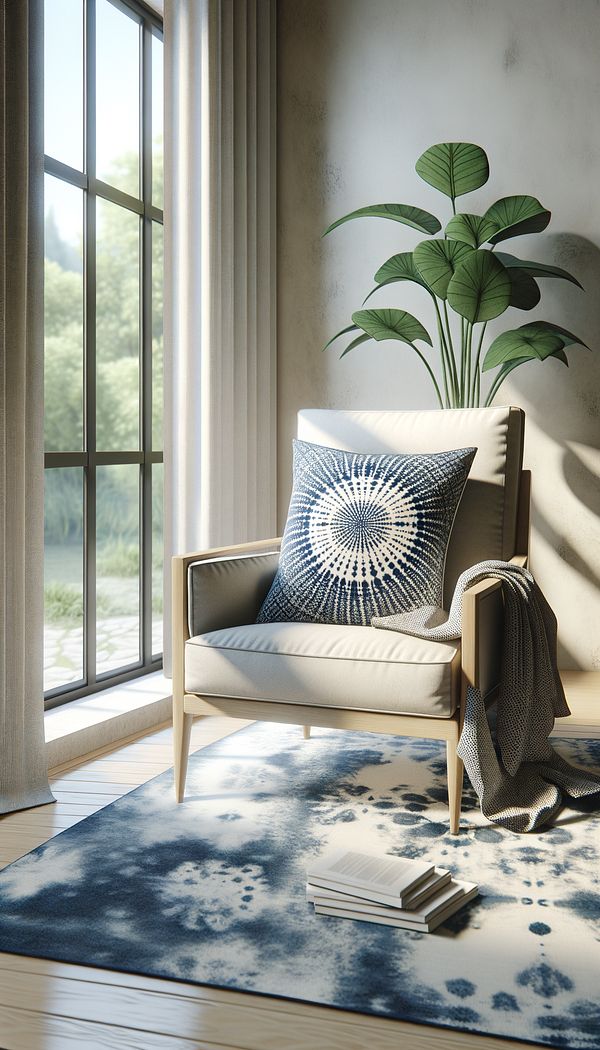What is Shibori?
Shibori is a Japanese manual resist dyeing technique, which produces patterns on fabric.
Description
Shibori is an intricate, traditional Japanese technique of decorating textiles that has been practiced for centuries. Originating in Japan, it involves a resist dyeing process in which fabric is folded, twisted, stitched, or compressed to create patterns. The areas of the fabric that are manipulated in this way resist the dye, resulting in unique patterns and textures. Unlike other dyeing methods, Shibori is known for its precision and the variability of its techniques, which can range from intricate, detailed patterns to more abstract and fluid designs.
The appeal of Shibori in interior design lies in its unique aesthetic and the touch of handcrafted elegance it brings to spaces. Each Shibori piece is unique, bearing the marks of the artisan's hands and their specific folding, twisting, or binding technique. The process not only involves skill and artistry but also a deep understanding of the fabric and dyes used, making Shibori textiles valued for both their beauty and craftsmanship.
In modern interior design, Shibori has been embraced not only for traditional Japanese-themed decor but also in contemporary, bohemian, and eclectic design schemes. Its versatility and timeless appeal make it a popular choice for adding texture, depth, and an organic feel to a variety of spaces, from residential homes to commercial settings.
Usage
Shibori is commonly used in interior design within fabrics for items like curtains, cushions, bed linen, and wall hangings. Its visually striking patterns and textures add a unique character to the space, making it a favored choice for those looking to incorporate a touch of artisanal craftsmanship and distinctiveness into their decor.
FAQs
-
How is Shibori different from tie-dye?
Though Shibori and tie-dye both involve resist dyeing techniques, Shibori is characterized by its intricate patterns and the variety of techniques used, each with a specific name and method, whereas tie-dye is more often associated with the specific technique of tying and dyeing fabric in the West with more spontaneous and less structured patterns.
-
Can Shibori be used in modern interiors?
Absolutely! Shibori is very adaptable and can contribute a unique, handcrafted element to modern interiors. It's especially suited to contemporary, bohemian, and eclectic decor styles, offering an interesting contrast to minimalistic designs with its rich textures and deep indigo hues.
-
Is Shibori only blue?
While the most traditional and widely recognized Shibori textiles are dyed using indigo, resulting in rich shades of blue, modern interpretations of Shibori can be found in a variety of colors. Artisans have expanded the palette to include a broad range of dyes, allowing for greater versatility in interior design applications.
-
How do you care for Shibori textiles?
Shibori textiles should be cared for according to the specific fabric and dye used. Generally, it's advisable to hand wash or use a gentle machine cycle with cold water, and avoid harsh chemicals. Always consult the care instructions provided by the artisan or manufacturer.
Practical Application
When incorporating Shibori into your interior design, consider using it as an accent to add depth and interest to a room. Shibori works well as a focal point, so pairing it with simpler textures and patterns can help it stand out. Experiment with different Shibori techniques and colors to match the mood and style of your space. For a cohesive look, pick out key colors from the Shibori pattern and reflect them in other elements of your room's decor.
-
Design Styles478 articles
-
Decorative Techniques322 articles
-
Materials & Textiles360 articles
-
Color & Patterns154 articles
-
Textiles & Upholstery252 articles
-
Decorative ArtsDecorative arts is a term that encompasses a wide range of arts and crafts designed to embellish interior spaces and objects.
-
WallpaperWallpaper is a material used to decorate the interior walls of a room.
-
ValueValue in interior design refers to the lightness or darkness of colors.
-
ChecksChecks refer to a pattern comprising of crisscrossed horizontal and vertical lines, forming squares.
-
Wall ClockA wall clock is a time-keeping device designed to be mounted on a wall.
